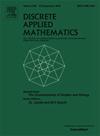Characterizing and computing in linear time mutual-visibility parameters in distance-hereditary graphs
IF 1
3区 数学
Q3 MATHEMATICS, APPLIED
引用次数: 0
Abstract
The mutual-visibility problem in a graph asks for the cardinality of a largest set of vertices so that for any two vertices there is a shortest -path whose internal vertices are all not in . Variations of this problem are known, based on the extension of the visibility property of vertices that are in and/or outside . It is known that solving the mutual-visibility problem in all its variations is NP-complete, whereas it has been shown that there are exact formulas for special graph classes like paths, cycles, blocks, cographs, and for the Cartesian product of some simple graphs like paths, cliques and cycles.
In this paper, we study the (variations of) mutual-visibility problem in the context of distance-hereditary graphs. In particular, we introduce the direct canonical decomposition of a graph as a tool for defining useful structural properties of the graphs studied. Then, we show that such properties allow us to devise a linear-time algorithm for solving all the variants of the mutual-visibility problem for distance-hereditary graphs. In turn, this allowed us to show that a recently posed conjecture about the total mutual-visibility number of distance-hereditary graphs holds.

距离遗传图中线性时间互可视性参数的刻画与计算
图G中的互可见性问题要求最大顶点集X的基数V(G),使得对于任意两个顶点X,y∈X,存在一条最短的X,y路径,其内部顶点均不在X中。基于X内外顶点可见性的推广,已知该问题的变型是np完全的,已知在其所有变型中求解互可见性问题。然而,对于特殊的图类,如路径、圈、块、图,以及一些简单图的笛卡尔积,如路径、团和圈,已经证明了有精确的公式。本文研究了距离遗传图的互可见性问题。特别地,我们引入图的直接正则分解作为定义所研究图的有用结构性质的工具。然后,我们证明了这些性质允许我们设计一个线性时间算法来解决距离遗传图的互可见性问题的所有变体。反过来,这使我们能够证明最近提出的关于距离遗传图的总互可见性数的猜想是成立的。
本文章由计算机程序翻译,如有差异,请以英文原文为准。
求助全文
约1分钟内获得全文
求助全文
来源期刊

Discrete Applied Mathematics
数学-应用数学
CiteScore
2.30
自引率
9.10%
发文量
422
审稿时长
4.5 months
期刊介绍:
The aim of Discrete Applied Mathematics is to bring together research papers in different areas of algorithmic and applicable discrete mathematics as well as applications of combinatorial mathematics to informatics and various areas of science and technology. Contributions presented to the journal can be research papers, short notes, surveys, and possibly research problems. The "Communications" section will be devoted to the fastest possible publication of recent research results that are checked and recommended for publication by a member of the Editorial Board. The journal will also publish a limited number of book announcements as well as proceedings of conferences. These proceedings will be fully refereed and adhere to the normal standards of the journal.
Potential authors are advised to view the journal and the open calls-for-papers of special issues before submitting their manuscripts. Only high-quality, original work that is within the scope of the journal or the targeted special issue will be considered.
 求助内容:
求助内容: 应助结果提醒方式:
应助结果提醒方式:


